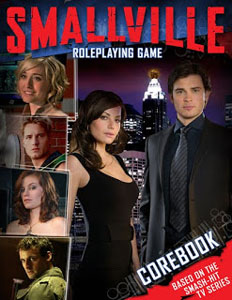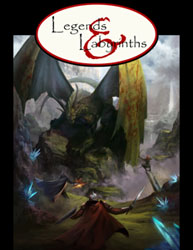Roleplaying games are a relatively new medium. And like most fresh-faced mediums, this means that a lot of advice given for creating and using the medium is being borrowed from existing mediums. It also means that most of this advice is wrong because the similarities between the old and new mediums is usually a lot more superficial than it may initially appear. (For example, it took decades before screenplays fully stopped mimicking theatrical scripts.)
At the moment, the subject of pacing in RPGs is a good example of this. A lot of the GMing advice you’ll find for pacing right now revolves around borrowing terms and concepts directly from film or television. Like a screenplay written using the techniques for live theater, some of this stuff works, but a lot of it doesn’t because film pacing is primarily about controlling the presentation of predetermined action and RPGs don’t (or at least arguably shouldn’t) have predetermined action.
(If you want an extreme example of this, consider Christopher Nolan’s Memento: The pacing of that film is entirely based on the careful presentation of information known to the writer / filmmaker. I can certainly imagine mimicking a Memento-like experience in an RPG, but the techniques you’d use to achieve it would be radically different from those Nolan used in the creation, filming, and editing of Memento.)
Understanding film pacing (as opposed to theatrical pacing) requires one to understand one of the fundamental principles of film as a medium: The ability to cut the film and splice it together.
Similarly, understanding pacing for an RPG requires one to understand the fundamental principle of the RPG medium: The conversation of meaningful choices.
THE CONVERSATION OF MEANINGFUL CHOICES
As I’ve said in the past, a roleplaying game is self-evidently about playing a role. Playing a role is about making choices as if you were the character. And those choices are made as part of a conversation.
 As D. Vincent Baker said in Apocalypse World:
As D. Vincent Baker said in Apocalypse World:
Roleplaying is a conversation. You and the other players go back and forth, talking about these fictional characters in their fictional circumstances doing whatever it is that they do. Like any conversation, you take turns, but it’s not like taking turns, right? Sometimes you talk over each other, interrupt, build on each others’ ideas, monopolize. All fine.
Or, to put it another way, the fundamental interaction of an RPG can be boiled down to:
GM: What do you want to do?
Player: I want to do X.
GM: When you try to do that, this happens. What do you want to do?
In actual practice, of course, the GM’s question is often implied, the conversation isn’t tidy, multiple players are involved, the rules can reshape the structure of the conversation, and so forth. But that’s the heart and core of everything that happens in a roleplaying game: The GM presents a situation; the players respond to that situation by making a choice; the GM adjudicates the outcome of that choice (and thus presents a new situation to which the players respond).
Regardless of how you try to fancy that interaction up, it’s fundamentally a loop. And the GM’s ability to control pacing sits specifically at the moment of his response (“when you try to do that, this happens”).
EMPTY TIME
Although the art of pacing in a roleplaying game is unique compared to other mediums, in practice it can be remarkably simple. The GM must identify and then eliminate, conflate, or (in advanced techniques) manipulate what I’m going to refer to as empty time: The gap between one set of meaningful decisions and the next meaningful choice.
Or, to put it another way, you want to skip over the “boring bits” where nothing is happening. And the trick to doing that is moving the players efficiently to the next moment in which they can make an interesting and meaningful choice without taking away such choices by skipping over them.
 I find it most convenient to think of the treatment of empty time as a continuum. At one end of this continuum, for example, you have gameplay like that found in a pure, old school dungeoncrawl: Essentially no time is skipped and every action is catalogued because the density of meaningful decisions is incredibly high. (In by-the-book OD&D, for example, a wandering monster check is made every single turn. Because of this, even if you ignore the high density of geographically-significant navigation decisions being made, the decision to take or not take a single action remains incredibly significant.)
I find it most convenient to think of the treatment of empty time as a continuum. At one end of this continuum, for example, you have gameplay like that found in a pure, old school dungeoncrawl: Essentially no time is skipped and every action is catalogued because the density of meaningful decisions is incredibly high. (In by-the-book OD&D, for example, a wandering monster check is made every single turn. Because of this, even if you ignore the high density of geographically-significant navigation decisions being made, the decision to take or not take a single action remains incredibly significant.)
This, by the way, is another reason why dungeoncrawls are such an effective scenario structure for new GMs: They basically eliminate any need for the GM to think about pacing. It’s an entire body of techniques that the GM can simply ignore while running the dungeoncrawl with confidence.
Once a GM leaves the dungeon, however, they’ll quickly realize that this technique doesn’t work. For example, imagine we were playing a game of Vampire: The Masquerade and I decided to handle the process of leaving my house and driving downtown like this:
GM: What do you want to do?
Player: I want to head downtown.
GM: How are you getting there?
Player: I’ll drive my car.
GM: Okay, you pull your car out of the garage and start driving down the alley. Do you want to turn left or right at the end of the alley?
Player: Left.
GM: Okay, you go half a block down to 10th Street. Which way do you want to go?
Player: Straight.
GM: Okay, you go another block down to Elliot. Which way do you want to go?
Player: Straight.
GM: Okay, you go another block down to Chicago Avenue. There’s a stoplight. It’s red. What do you want to do?
Player: I’ll wait for the light to turn green and then turn right.
That’s self-evidently moronic. None of those decisions are meaningful. Nobody is having fun. And that’s how we end up with interactions that look like this:
GM: You’re at the city gate. What do you want to do?
Player: We go to the Tavern of the Lonely Wench.
GM: Okay. As you walk through the doors of the Lonely Wench…
Whoa. What just happened? We skipped over a whole bunch of stuff and – BAM! – we’ve suddenly framed a new scene at the tavern.
INTENTIONS vs. INTERRUPTIONS / OBSTACLES
We’re going to be taking a closer look at what it means to frame a scene later, but first I want to focus on how the new scene was selected. We’ve moved slightly up the scene-framing continuum here by skipping to the intention: The players said they wanted to achieve something and the GM skipped to the moment at which they’d achieved it.
If you’re the GM, this basically involves asking yourself two questions: What is the current intention of the PCs? And does anything interrupt that intention?
In this example, identifying the intention is really easy: The player told you, point-blank, what they wanted to achieve. Interruptions (which you can also think of as obstacles standing between the PCs and their desired outcome) could take any number of forms: Do they get ambushed by assassins? Or run into an old friend? Or have an opportunity to pick a rich nobleman’s pocket? Or spot a rare tome of lore at bargain basement prices?
In determining these interruptions and obstacles, we begin to see the motivations and techniques of the GM coming into play: Does the interruption happen because you’re using a random table of simulated events? Because you need to key the next plot arc? Because the next event on your prepared timeline is due to occur? Because you have a creative whim? Because you want to activate a tag on one of your PCs?
So, to sum up:
- Identify the intention
- Choose obstacles
- Skip to the next meaningful choice
In the Art of Rulings I wrote that, “When in doubt, look for the meaningful choice.” And the same principle applies here.
As we continue moving up the continuum of scene-framing, what basically happens is that the threshold of interest required to frame the next beat is cranked up. For example, if we nudge it up just a tick:
GM: You’re at the city gate. What do you want to do?
Player: We go looking for a tavern.
GM: Okay, you’re in the Tavern of the Lonely Wench.
Spot the difference? The GM decided that the choice of which tavern the PCs wanted to go to was irrelevant, so he skipped it, picked the tavern for them, and started the next scene. If he’d decided not to frame the scene quite so hard, he could have asked, “You want an upscale joint or a downscale joint?” Or offered them a selection of different taverns and allowed them to choose. (Or both.)
(And, conversely, by asking those questions, the GM is basically saying, “Either you or I or both of us care about whether the tavern is upscale or downscale.” Either because that choice tells us something interesting about the characters; or changes the amount of gold they will spend; or determines the likely encounters they’ll have there; or makes it easier to spot the spies tailing them; or any number of other possibilities.)
The harder the frame, the higher the level of interest needs to be before we stop fast-forwarding (and the more decisions get skipped). For example, maybe the GM decides that the tavern is completely boring and instead we get:
GM: You’re at the city gate.
Player: We go looking for a tavern.
GM: You party long and hard into the night, so you’re still a little hung-over the next morning when you’re shopping for supplies at Dink’s store and spot a shoplifter slipping a gold watch into his pocket.
And we can keep cranking:
Player: Okay, we’re done at the dungeon. Let’s head back to town.
GM: It’s two weeks later and you’re shopping for supplies in Dink’s store. You spot a shoplifter slipping a gold watch into his pocket. You shout, “STOP THIEF!” and he starts running for the door. What do you do?
The more you crank it up – the harder you frame the scene – the more latitude the GM has for expressing their creative agenda and the larger their influence over the course of the game becomes. This is because the decision to skip “empty time” is hiding a railroad… it’s just that you’re “railroading” past decisions that everyone at the table agrees are irrelevant.
 The risk, of course, is that you skip past a decision that is important to someone at the table. The Smallville RPG, which advocates for strong and aggressive scene-framing, offers this advice:
The risk, of course, is that you skip past a decision that is important to someone at the table. The Smallville RPG, which advocates for strong and aggressive scene-framing, offers this advice:
If, despite your best efforts, you skip a little too far ahead and a player says, “But I wanted to—“ just hand him a Plot Point. Tell him to spend it on revealing his planned preparations in the middle of the scene. With luck, he’ll surprise the rest of the table with an unforeseen turn of events.
This sort of solution is not unusual. In fact, the more you crank it up, the more typical it becomes for the game or the GM to start introducing more STG / narrative control mechanics and techniques: The GM is taking so much control away from the players that it becomes necessary to compensate by giving them back control in other ways.
Of course, in actual practice GMs will vary the pace of their scene-framing considerably depending on context and circumstance. But basically “skip the boring stuff and get to the next meaningful choice” is all you really need to know about pacing in an RPG.
The difficult part, of course, is putting that simple maxim into effective practice.
THE ART OF PACING
Part 2: Scene-Framing
Part 3: Filling the Frame
Part 4: Closing the Frame
Part 5: Advanced Techniques
Part 6: More Advanced Techniques
SUPPLEMENTAL READING – THE ART OF PACING
Film Banging: The Avengers
Film Banging: Alien
Film Banging: The Matrix
The Art of Pacing: Prepping Bangs
The Art of Pacing: Running Awesome Scenes
The Art of Pacing: How NOT to Frame a Scene



 I got subscribed to Hogwash one day while I was perusing
I got subscribed to Hogwash one day while I was perusing 










